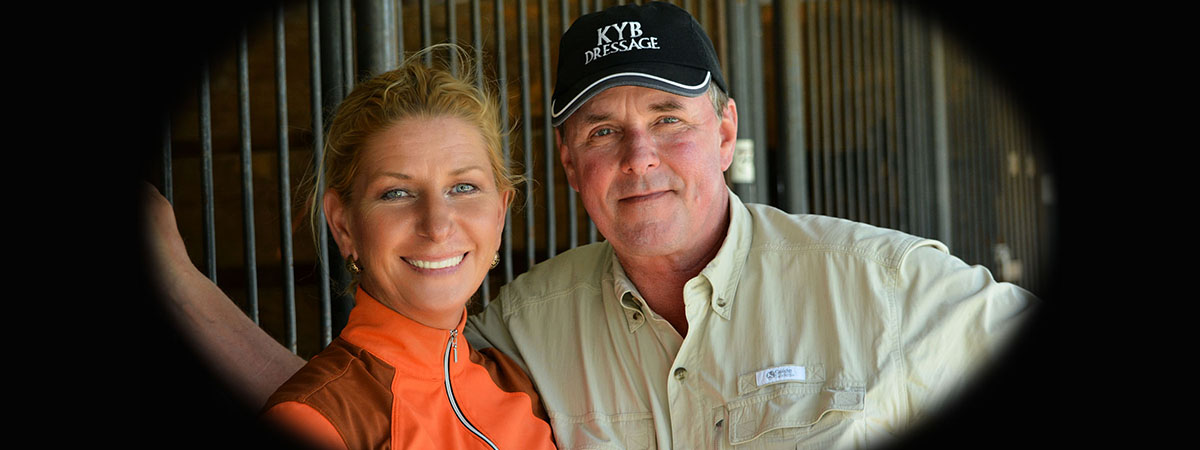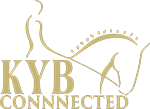Retraining the Thoroughbred Racehorse for Dressage
By Yvonne Barteau
Many of you may not know that I spent seven years working with standardbred and thoroughbred racehorses around the racetracks of the United States and Canada. I started as a groom and I learned so so much about caring for young, hard working horses, under a great deal of pressure and stress. I exercised, groomed, and eventually became a trainer in the standardbred racing industry, moonlighting at the thoroughbred track between seasons. There is a lot to be concerned about working horses so hard, at the very young ages that thoroughbreds and Standardbreds start racing, but there is much to like about the thoroughbred horse as an athlete in general.
Years ago, after leaving the racetrack behind, I retrained some thoroughbreds as Eventing prospects reselling them when they were ready to put together a lower level dressage test and go over some fences without tension or worry. I find thoroughbreds to be hard working horses quite capable of converting into the dressage discipline… if a few key elements about their background, are factored into their training program. Life has taken me in a different direction these past twenty years and I have had limited exposure to the racing breeds during that time. More recently, I have gotten involved with the thoroughbred breed again by participating in the Retire Racehorse Thoroughbred Makeover Challenge with my new friend Seventy Two or “Indy” a six year old gelding I bought off of a cell phone video less than a year ago.
In six months he has learned all of the training and first level work and we are working on lead changes, schooling pirouettes, half steps and all lateral work. In addition he can lay down, bow and do some liberty work. He likely will train to the PSG and possibly beyond. I will share some of the techniques I used to bring him along in both video and written format.
I also have another six year old gelding, who left the race track and did a year of Western work and is just now starting his journey as a dressage mount. His name is Trick Roper but we all call him “Buddy”. He has some different issues from Indy so we will talk about his program and make some video tutorials about his journey as well.
In general it is best to understand how a “Racehorse” is educated because if a thoroughbred were in a training or racing environment, specific to the racing industry, for any length of time that is, and will be, their memories. So…while thoroughbreds understand that they need to work, sweat and exert themselves they know nothing about connection, leg aids, lateral work or body control things we often start with our youngsters, quite early on. Relaxation is not “built in” to this breed, or into their racetrack training program, and should not be expected, but more worked towards, during the early retraining.
Connection, shoulder control, and leg aids go hand in hand but each must be understood by rider and horse as a unit. Many thoroughbreds lean on the bit, pushing their chest and forehand through it so they can propel themselves on their forehand. Some, will hide from the connection or chomp the bit and retract their neck. Connection is such an important and vital requirement for dressage that it must be addressed early on.
A good Connection is vital, and as complicated, as it is simple. Connection is just a soft elastic feeling between horse and rider that is a conduit to information coming and going between the pair. It is NOT a head set or head position. A horse can be properly or improperly connected regardless of their head position but when a horse is connected, ahead of the leg, and has developed an understanding of how to work in this manner, their head often is, where it should be, for them to do their job. However that is a by product, not a starting point.
Surprisingly, many thoroughbreds, while full of energy and often quite naturally fit, are technically speaking, “behind the leg”. To me being behind the leg means many things. No understanding of leg aids, legs not working through the horses body or encouraging the horse to use his body, legs not working through to the connection. Often this, being behind the leg, is part of the reason for the tension thoroughbreds experience under saddle.
The leg communication must work between rider and horse, and the connection cannot feel Ike a trap.
One of the first things I have done with these last two thoroughbreds, after their initial ground work, is to teach them to longe with side reins slightly longer than I might normally have them. This to encourage these somewhat tight backed horses to reach for the connection and to balance themselves on a 15-18 meter circle through many transitions without the burden of carrying a rider through the process. Also it helps them start a valuable communication process that will carry into the riding work.
A groundwork and longeing program may need to be ongoing through the introduction to the riding work as well, as it has a separate benefit. The actual riding connection of course can be much more individually managed. I start by just taking a soft feel of both reins and then using my legs to kind of herd the horse up to the contact in left or right positioning.

If the horse puts their head up in the air, I do not immediately try to put it back down. If the speed changes then I will address that with half halts but the half halts can work and still be separate from neck or head position. So if the head is up but the speed is under control then try to pick a flexion rein, while the head is up, and half halt with soft upward and sideways away from the flexion rein half halts to get the horse to dislodge his shoulders and withers, slightly away, from the flexion rein. If the horse speeds up, or does something besides what you desired, go back to walk. Then try for the flexion and shoulder, or rein yielding control from there. This is an important first step. Getting shoulder control while you work on connection, and flexion all go together.
It is important to mention that any aid which is understood but not answered by the horse has to get louder in dosage or frequency and removed the instant the horse responds. I find as an instructor this comes up quite often. Many new riders are reluctant to get louder with the aids feeling it unfair or unkind. The kindest thing we can do as riders is to insist our horse answer our requests so we can leave them alone and ride quietly. All of these issues will be looked at in greater detail in the coming months.
Video segments from groundwork to longeing, initial rides through competition preparation will all be covered in a new KYB Connected series. Our goal with these tutorials is to help any and all horsemen, many who work on their own, and to give professionals or amateurs another perspective on the work they already do everyday.
Please check back in with KYB Connected or send us an email on what you would most like to learn about. We are a horse training community. [email protected]
Happy Riding!
retraining the thoroughbred for dressage from KYB Dressage on Vimeo.




